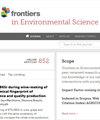中国三个沿海海湾不同鱼类的甲基汞污染水平变化及相关健康风险
IF 3.3
3区 环境科学与生态学
Q2 ENVIRONMENTAL SCIENCES
引用次数: 0
摘要
中国大气汞(Hg)排放量不断增加,引起了人们对海水鱼类污染的持续关注。为了更好地了解污染模式和相关风险,我们研究了中国沿海三个地理位置不同的海湾中常见的四个鱼科的底栖和中上层鱼类体内的甲基汞含量。我们发现,在不同地区,同一鱼类家族中的甲基汞含量存在明显的空间差异。具体而言,与中国东北部莱州湾和/或东部海州湾的鱼类相比,从中国南海北部湾采集的鱼类的甲基汞含量一直较高。相比之下,从海州湾采集的鱼类甲基汞含量一直最低。在每个区域内,我们都观察到底栖鱼类的甲基汞浓度明显高于中上层鱼类。这一趋势在北部湾的翘嘴鲉(Platycephalus indicus)、小鳞舌鳎(Cynoglossus microlepis)和大蜥蜴鱼(Saurida tumbil)(分别为0.50、0.21和0.18毫克/千克干重)以及莱州湾的翘嘴鲉和细长蜥蜴鱼(Saurida elongata)(分别为0.09和0.12毫克/千克干重)中尤为明显。相比之下,这三个地区的银鲳体内的甲基汞含量始终低于其他鱼种。通过目标有害商数(THQ)计算,我们估算了当地居民食用所研究鱼类物种可能带来的健康风险。我们的结果表明,三个地区获得的所有 THQ 值都在安全范围内(0.02-0.94),对当地居民没有明显的健康风险。然而,进行更多的评估和时空监测,涵盖更广泛的物种和地区仍然非常重要。本文章由计算机程序翻译,如有差异,请以英文原文为准。
Variations in methylmercury contamination levels and associated health risks in different fish species across three coastal bays in China
The growing atmospheric mercury (Hg) emissions in China have raised ongoing concerns regarding contamination in marine fish. To better understand the pollution patterns and associated risks, we examined methylmercury (MeHg) content in demersal and pelagic fish from four commonly found families in three geographically distinct bays along the Chinese coast. We identified significant spatial variations in MeHg levels within the same fish family across regions. Specifically, fish collected from the Beibu Gulf in the South China Sea consistently exhibited significantly higher MeHg levels compared to those from the Laizhou Bay in the Northeast and/or Haizhou Bay in the East of China. In contrast, MeHg levels in fish collected from Haizhou Bay consistently remained the lowest. Within each region, we observed significantly higher MeHg concentrations in demersal species compared to pelagic species. This trend was particularly evident in fish species including bartail flathead (Platycephalus indicus ), small-scale tongue sole (Cynoglossus microlepis ) and greater lizardfish (Saurida tumbil ) from the Beibu Gulf (0.50, 0.21, and 0.18 mg/kg dw, respectively), as well as bartail flathead and slender lizardfish (Saurida elongata ) from Laizhou Bay (0.09 and 0.12 mg/kg dw, respectively). By comparison, MeHg content in silver pomfret (Pampus argenteus ) from all three regions consistently remained relatively lower than in other species. Using target hazardous quotient (THQ) calculations, we estimated potential health risks in local populations associated with the consumption of the studied fish species. Our results showed a lack of apparent health risks to local residents, as all THQ values obtained from the three regions fell within the safe limits (0.02–0.94). However, it remains important to conduct additional assessments and spatiotemporal monitoring that encompass a broader range of species and regions.
求助全文
通过发布文献求助,成功后即可免费获取论文全文。
去求助
来源期刊

Frontiers in Environmental Science
Environmental Science-General Environmental Science
CiteScore
4.50
自引率
8.70%
发文量
2276
审稿时长
12 weeks
期刊介绍:
Our natural world is experiencing a state of rapid change unprecedented in the presence of humans. The changes affect virtually all physical, chemical and biological systems on Earth. The interaction of these systems leads to tipping points, feedbacks and amplification of effects. In virtually all cases, the causes of environmental change can be traced to human activity through either direct interventions as a consequence of pollution, or through global warming from greenhouse case emissions. Well-formulated and internationally-relevant policies to mitigate the change, or adapt to the consequences, that will ensure our ability to thrive in the coming decades are badly needed. Without proper understanding of the processes involved, and deep understanding of the likely impacts of bad decisions or inaction, the security of food, water and energy is a risk. Left unchecked shortages of these basic commodities will lead to migration, global geopolitical tension and conflict. This represents the major challenge of our time. We are the first generation to appreciate the problem and we will be judged in future by our ability to determine and take the action necessary. Appropriate knowledge of the condition of our natural world, appreciation of the changes occurring, and predictions of how the future will develop are requisite to the definition and implementation of solutions.
Frontiers in Environmental Science publishes research at the cutting edge of knowledge of our natural world and its various intersections with society. It bridges between the identification and measurement of change, comprehension of the processes responsible, and the measures needed to reduce their impact. Its aim is to assist the formulation of policies, by offering sound scientific evidence on environmental science, that will lead to a more inhabitable and sustainable world for the generations to come.
 求助内容:
求助内容: 应助结果提醒方式:
应助结果提醒方式:


